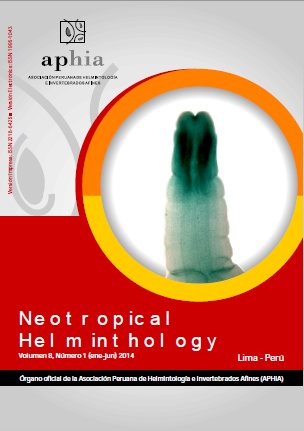MICROHABITAT PREFERENCE AND SEASONALITY OF GILL MONOGENEANS IN NILE TILAPIA REARED IN SOUTHERN BRAZIL
DOI:
https://doi.org/10.24039/rnh201481897Keywords:
Oreochromis, monogenean parasites, gills, season.Abstract
Few studies have been done to evaluate the monogenean microhabitat preference. This study evaluated the monogenean distribution among different gill arches of Nile tilapia Oreochromis niloticus and seasonality. A total of 89 fish were captured in a pond located in Chapecó, Santa Catarina, for parasitological analysis. After fish euthanasia, the gill arches were removed, separated from the most external to the most internal and named as I, II, III and IV. Transparency, pH, oxygen, temperature, alkalinity, conductivity, ammonia, iron, orthophosphate, sulfide, nitrite and nitrate of water pond were measured. In spring 2008 the mean abundances of the monogeneans (Scutogyrus longicornis, Cychlidogyrus sclerosus, C. thurstonae and C. tilapiae) in the arches I, II, III and IV were, respectively, 11.45, 14.45, 13.8, 13.15, in summer 2008 theywere 13.12, 12.25, 14.94, 21.53, in summer 2009 they were 2.75, 3.25, 2.45, 2.45, in autumn 2009 they were 13.44, 18.78, 11.78, 9.22 and in winter 2009 they were 0.35, 0.5, 0.3, 0.5. Monogenean preference for microhabitat in the gills of farmed Nile Tilapia was not observed. A significant increase of parasites in spring and summer 2008 and autumn 2009 was observed. The highest number of parasites coincided with seasons of high water temperature. The lack of microhabitat preference among the gill arches suggest homogenous distribution of parasites combined with water quality parameters.
Downloads
Published
How to Cite
Issue
Section
License
Copyright (c) 2021 Neotropical Helminthology

This work is licensed under a Creative Commons Attribution-NonCommercial-NoDerivatives 4.0 International License.
OBJETO: El AUTOR-CEDENTE transfiere de manera TOTAL Y SIN LIMITACIÓN alguna al CESIONARIO los derechos patrimoniales que le corresponden sobre la (s) obra(s) tituladas: xxxxxxxxxxxxxxxx, por el tiempo que establezca la ley internacional. En virtud de lo anterior, se entiende que el CESIONARIO adquiere el derecho de reproducción en todas sus modalidades, incluso para inclusión audiovisual; el derecho de transformación o adaptación, comunicación pública, traducción, distribución y, en general, cualquier tipo de explotación que de las obras se pueda realizar por cualquier medio conocido o por conocer en el territorio nacional o internacional.
REMUNERACIÓN: La cesión de los derechos patrimoniales de autor que mediante este contrato se hace será a título gratuito.
CONDICIONES Y LEGITIMIDAD DE LOS DERECHOS: El AUTOR-CEDENTE garantiza que es propietario integral de los derechos de explotación de la(s) obra(s) y en consecuencia garantiza que puede contratar y transferir los derechos aquí cedidos sin ningún tipo de limitación por no tener ningún tipo de gravamen, limitación o disposición. En todo caso, responderá por cualquier reclamo que en materia de derecho de autor se pueda presentar, exonerando de cualquier responsabilidad al CESIONARIO.
LICENCIA DE ACCESO ABIERTO: El AUTOR-CEDENTE autoriza que manuscrito publicado en La Revista Neotropical Helminthology permanece disponible para su consulta pública en el sitio web https://www.neotropicalhelminthology.com/ y en los diferentes sistemas de indexación y bases de datos en las que la revista tiene visibilidad, bajo la licencia Creative Commons, en la modalidad Reconocimiento-No comercial- Sin Trabajos derivados –aprobada en Perú, y por lo tanto son de acceso abierto. De ahí que los autores dan, sin derecho a retribución económica, a la Asociación Peruana de Helmintología e Invertebrados Afines (APHIA), los derechos de autor para la edición y reproducción a través de diferentes medios de difusión.


 Numero 2 Volumen 19 - 2025 (versión Anticipada)
Numero 2 Volumen 19 - 2025 (versión Anticipada)














































